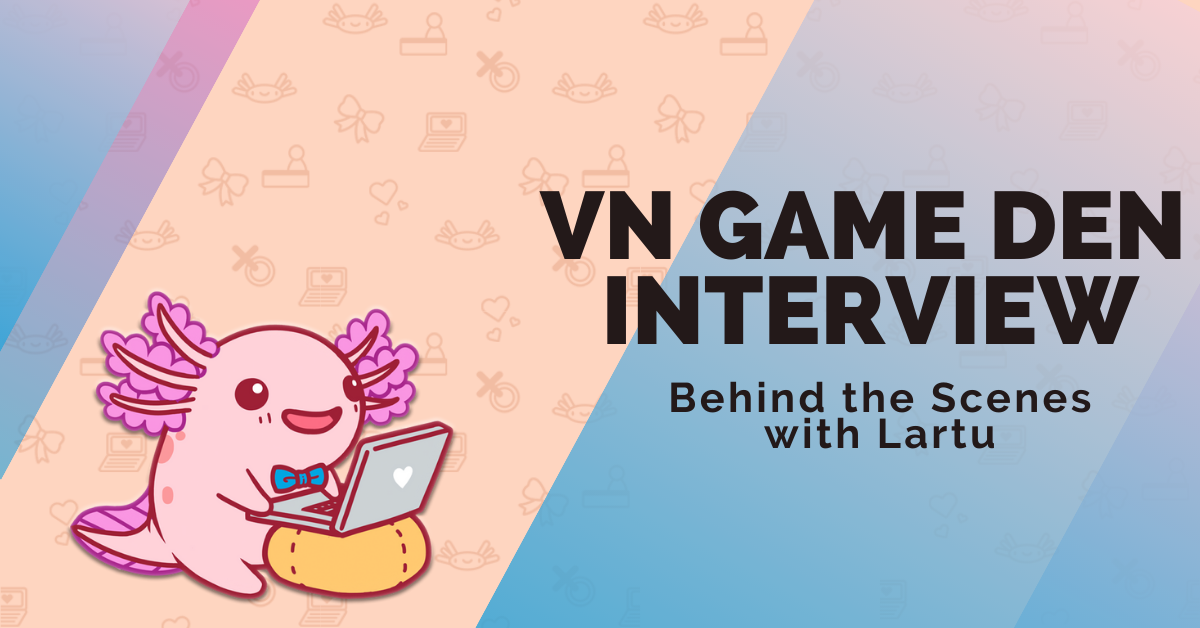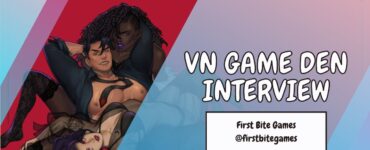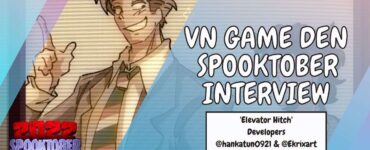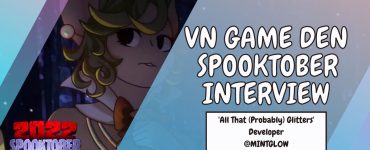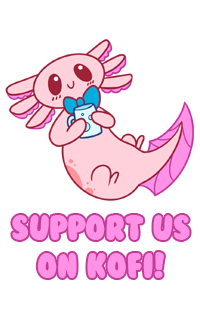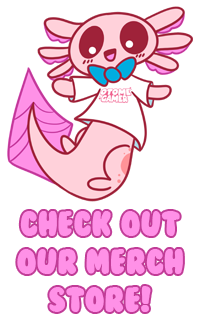Lartu is a video game and software developer, known for the production of games such as Aidinia: An Epic Adventure!, Eternal Lux, Fateful Lore and Soft Drizzle. They started out making flash games and eventually found themselves on the mobile market, finally settling down now in making browser based games in 2021.
You may recognize Lartu’s entry to the 2020 Spooktober Jam, Soft Drizzle: B Track, which won the title of Best Unity Submission!
We sat down with Lartu to talk about their experience entering the Spooktober Jam, making visual novels in unity, and more!

You created Soft Drizzle: B-Track for the 2020 Spooktober Game Jam. Can you briefly tell our readers what the game is about?
Of course! Soft Drizzle: B-Track is a light-hearted visual novel about three friends that go to a Halloween festival. They spend the afternoon there, escape from an escape room and then go for dinner. It’s a direct sequel to another visual novel I made for a jam, accordingly called Soft Drizzle. It’s very short, sweet and simple!
What inspired the premise of this game?
Before developing Soft Drizzle: B-Track, I had spent some time playing Danganronpa V3, 1 and 2 (in that order, I messed up and spoiled everything for myself!) and the first two Frog Detective titles. I wanted to develop a game like those. I’m a big fan of detective-ish games like Ace Attorney or Professor Layton, and decided to go with something that played like Danganronpa but drew some of the charm Frog Detective had. I started making a game about hand-drawn animals that solved crimes, but something about having animal protagonists didn’t quite resonate with me.
Parallel to that, I was spending my evenings playing Factorio with a very close friend of mine. We used to talk on Discord while listening to music using a neat little bot called Groovy that let us listen to the same tunes at the same time. At some point during the long play-through of the aforementioned title, we started playing the song Matryoshka (from Vocaloid) over and over again. And then Matryoshka remixes and everything in between. Its video clip has a rather unique art style and depicts two female characters. After watching it a thousand times, inspiration struck, and I decided to participate in a jam and make a visual novel with human characters inspired by those of Matryoshka. That game would end up becoming Soft Drizzle, the prequel to Soft Drizzle: B-Track.
I went to itch.io to look for a jam to participate in, and I found the Low-Res Jam, whose premise was to develop games that fit in a screen resolution of just 64 by 64 pixels. Everything then fell into place: I don’t have the skills to draw well-drawn human characters for a full-fledged visual novel, but I have some experience in pixel-art and in a 64×64 square I can manage. And, I must admit, the challenge of developing a playable visual novel for such a tiny resolution sucked me in!
Soft Drizzle: B-Track draws inspiration from multiple places; for the gameplay and graphics, old PC-98 VNs, the Jake Hunter series for Nintendo DS, pixelated 3D games like A Short Hike and the investigation scenes from the Danganronpa Series; for the plot, I’m thinking Frog Detective, but there are probably other IPs there, maybe Night in the Woods, A Short Hike -again- and Undertale. In these titles, there are moments in the plot (or their entirety) where nothing happens, and I enjoy those moments very much. Those are moments of relaxation, introspection and bonding, both with other characters and with the world of the game. Such an experience! So Soft Drizzle: B-Track is just that, a visual novel about nothing relevant. Nothing bad happens. Nothing epic or unusual happens. It’s like going out with friends. And I believe this ended up being especially relevant for many players of both titles in the series, having 2020 been what it was.

Soft Drizzle: B-Track won the award for best unity game in the 2020 Spooktober Jam. Can you speak about what it’s like making a visual novel in unity? Are there particular pros and cons?
I love Unity! It’s an amazing engine. It lets you prototype and develop things with a lot of ease, with practically no limits but your skills and imagination. Many game developers attempt to reinvent the wheel and create their own engines for their games. And while this is okay, I believe it hurts more than it helps, because you are spending time on something that’s not your game per se, and that might negatively affect your motivation in the long run. I’ve seen it happen to many, including myself, multiple times.
All that said, though, using Unity for a visual novel is a little like reinventing the wheel. It’s not a visual novel engine, but it provides you with a lot of things already done that help you get things up and running quickly, while allowing for many things regular visual novel engines don’t – such as a 3D escape room. It’s a tradeoff, but I find game development in Unity to be easy, fast and rewarding if you put some effort into it. You can do anything you want.
On the negative side, the only thing I can complain about is that game files end up a little large, but the engine has come a long way in this regard, and the issue it’s not as bad as it used to be. Overall, the positive things outnumber the negative by a lot.
Soft Drizzle has a charming pixel style that is actually pretty unique among most OELVNs. Why did you choose this particular art style?
Thank you, I’m glad you like it! I chose this style because of three reasons.
First, as I told you before, the graphics were originally made for Soft Drizzle, and then fine-tuned and recoloured for B-Track. So the pixel style is due to the 64 by 64 resolution limitation of the jam I made the first game for. At this time, I was also thinking about developing a game for Palm OS (remember Palm Pilots?) so I designed them as 1-bit sprites that I could port later to monochrome devices. I ended up not doing that and adding two more colours for a total of three colours for the sprites (pink, purple and a very dark blue), and four for the backgrounds, to simulate a Game Boy Color-ish fantasy console.
Second, the aforementioned Matryoshka video. The original sprite sketches were based on frames from it. I ended liking what I found there very much, so I went with it.
Third, the colour palette for the game has a limited number of colours. I don’t remember how many, but I had also planned to release Soft Drizzle: B-Track for another jam that happened at the same time that required you to use a particular colour palette. I didn’t make it in time for that one, though, as it finished some days before the 2020 Spooktober Jam.

Creating a game featuring an escape room in just a month must have been hard. Can you speak about some of the difficulties you’ve faced?
Well, working, studying and developing games at the same time drives you crazy. Not to mention also having to set some time apart to sleep! Other than that, I had envisioned a longer, but equally simple, plot for B-Track. I wanted for the player to be able to walk around a 3D city, talking to characters and examining scenes, but in the short timeframe, that was obviously not possible. So I had to reduce the scope a lot, shorten the story and make the gameplay simpler.
Also, there was one point during the development of the game, with four or five days left for the deadline, where I started to have some issues with Windows and Unity. Due to bad planning, I had left the development of the escape room for last. That had already made things quite harder because it ended up being much more work than I had expected. It was supposed to have two rooms, not only one, another friend of mine had designed the room that ultimately didn’t make it, but it all went downhill one day when Windows decided it couldn’t take it any more and crashed and rebooted. When I reopened Unity, my project was corrupted. It was unreadable! I was on the verge of a nervous breakdown, but thankfully I had been very careful with the way I was backing my project up, and I was using git for version control – locally and remotely –, so I had a working version from not that long ago. All I had done for the escape room, however, was lost, and I had to do it from scratch again.
After that, thanks to the constant crashes and reboots I was facing with my computer – in the end, it turned out that my video card was dying – my local git repository got corrupted too. Also, a gas pipe broke at home. It was a wild ride, I cannot believe I actually finished the game in time under those conditions!
You mentioned having to cut out the second escape room in your game. Is there anything else you had to take out, or couldn’t include due to any restrictions of the jam (or other reasons)?
I would’ve liked to add some other things, yes! Due to lack of time, it wasn’t possible, but the original idea was to let the player walk and explore the Halloween Fair and play kermesse games while interacting with the environment. I programmed a whole graphical adventure interface for this, so players could click on things, pick items up, examine props, etc. I ended up using it in very few places, but it’s heavily featured in the escape room scene.
Also, I wanted to remake Soft Drizzle, the original game, with the new engine and release Soft Drizzle: B-Track as a compilation of both titles. It would’ve had a title screen to choose which game to play, so you’d be able to play the first entry before diving into the Halloween themed one. This was scrapped because the first game uses some weather effects that its sequel doesn’t, and I didn’t have enough time to program them in and also port the whole script to the new engine.
Would you ever consider going back and expanding upon these shorter jam games?
Hm, that’s a tough question! I’m not sure if I would expand upon them, really. I like them the way they are, they have their strong points and shortcomings, but they are what they are. Expanding the experience would be stretching things too far. However, I’d like to remake them at some point, particularly the first title, and I still have to revisit it to correct some typos (writing a whole script for a short jam doesn’t leave you with much time for proofreading!). I would love to port them to more platforms and, someday, release another title in the series. I enjoy spending time doing silly, non-consequential things with Himari and Fuyuko, and I’m eager to see what the future has in store for them!

Do you have any advice for people who may want to enter a game jam in the future?
Yes! Reduce. Your. Scope. Seriously! When people think about making a game, they want to make their dream game. That’s perfectly okay, of course, but our perfect game usually requires a big studio with hundreds of developers and artists, and we don’t generally have that kind of manpower at our disposal. A tiny game is perfectly doable, though. A big game is perfectly doable, too, but aim for a minimum viable product, release it, gather feedback and then add any content you want after the game is out. It’s easier and much more rewarding to add content to a game once people are playing it and tell you how much they’ve liked it (or not, case in which you can use the updates to fix stuff) than to keep adding content to a game that’s in feature-creep hell and never coming out.
Over the course of my life, I have started and abandoned a myriad of projects. I’m sure I’m talking about hundreds of game ideas here. But at the beginning of 2020, I joined forces with some friends from college and we released Fateful Lore, a retro-inspired RPG for mobile devices, that had an incredibly positive reception. In fact, a very big publisher from South Korea approached us to talk about a possible partnership with them! It was amazing. During the development of FL, I realized some key things that have since helped me finish other projects too:
First, try to find a project you are passionate about. This sounds like a cheap motivational talk, but seriously, think about it. Am I going to want to continue to work on this tomorrow? Next week? In a month? Think deeply about a project before even writing the first line of code for it. Make sure you really want to work on it and that you are not going to discard it when the next shiny, big project idea comes.
Second, take your project and separate it into little, doable tasks. Make a to-do list of all the things you have to do to complete your game. Make a Kanban board, think agile. Do you need a character that can walk across a map? Then separate that into “map loading”, “character movement”, “collisions”, “camera movement”, etc. During the development of Fateful Lore, I made the mistake of creating a single task in our Trello board that just said “Battle System”. A single task. The battle system took us weeks and, of course, our estimations for when the game would be complete immediately went down the drain. Also, separating everything you have to do into single tasks lets you tackle them easier, and also gives you some perspective on how much you have left to do before the game can be released. It helps keep your anxiety down.
Third, trim the fat. Reduce your scope, again! Your game has a lot of unnecessary content, go remove it! You are making an RPG? Okay. Do you NEED the crafting system? Does your FPS really, really NEED to have twenty maps instead of one or two? You can add this content later, as stated before, but you should be working towards an MVP. Once that’s done, you have a game. That way better than having a colossal game under development forever.
Fourth, focus. This was hard for me! You are working on a game already, do not try other potential prototype ideas. Focus on what you are doing and finish it. You can start the next big thing later.
Fifth, try to not have a “zero-day”. This means to work at least a tiny little bit on your game every single day. After all, little progress is better than no progress at all. Mother Theresa had a saying, “We ourselves feel that what we are doing is just a drop in the ocean. But the ocean would be less because of that missing drop” – your game would be less without that little work. And little work piles up and your game will be finished eventually.
And sixth and last, use social media to your advantage. Upload footage of your game, tell people about it, keep showing it to the world. You will not only build a following for when your game is ready, but you will also gather feedback and positive comments that will keep you motivated. People tend to be very supportive when they see others making games.
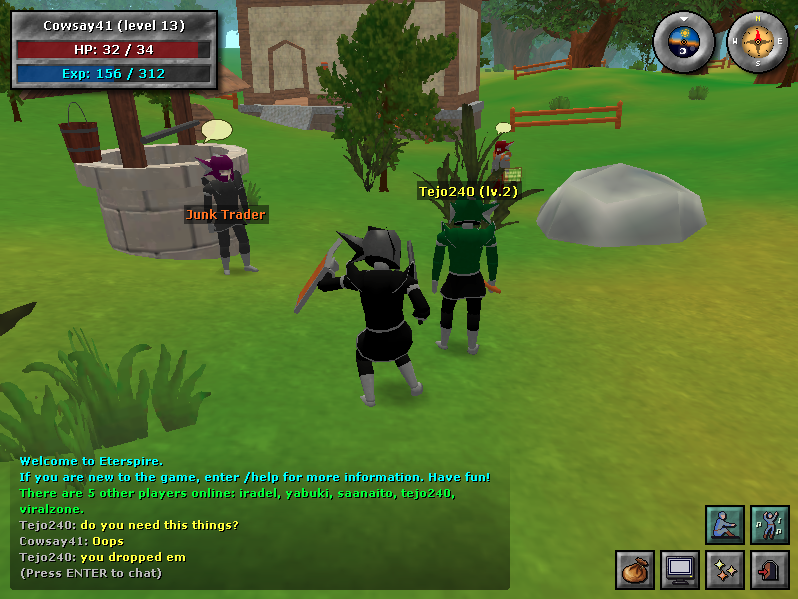
You also make RPG games. How does that differ from your experience making visual novels? Do you prefer one over the other?
Well, my RPGs tends to focus more on exploration than on heavy dialogue. I do love dialogue in RPGs, and mine tend to have a lot of it, but you spend more time walking and discovering places than talking to characters. So that calls for an entirely different development cycle. My visual novels are simpler in that regard because I don’t like multiple endings, and linear storytelling is easier to code. I cannot talk about branching, complex VNs and RPGs, because I haven’t developed any.
I can’t say I prefer one over the other, really. I love some visual novels, Ace Attorney, Danganronpa, Professor Layton. I love some RPGs, such as Final Fantasy, Ultima or Pokemon. My favourite genre is, without a doubt, MMORPGs, but because of the exploration experience they offer, I enjoy that. Games like Night in the Woods offer exploration and great writing, and they are neither RPGs nor visual novels, so I’d say I prefer games that offer a well-crafted ambience, lovable characters and a world to get to know. Some RPGs offer that, some VNs do too.
Are there any projects you’re working on that VN Game Den readers can look forward to?
At the moment, I’m working with a friend on Eterspire (www.eterspire.com) an indie MMORPG focused on exploration. We’ve hand-crafted a world filled with interesting characters, places to explore and treasure to find, and we are enjoying the experience very much. I believe VN Game Den viewers will enjoy it because we are putting a lot of effort into creating memorable NPCs with fun dialogues and interactions you can talk with and complete quests for. When was the last time you played an MMORPG that had NPCs you actually cared about? I can’t say I remember playing a game like that at all (unless maybe Club Penguin? But that’s not an MMORPG!), so we’ve decided to give the genre a twist. It’s browser-based, it’s free and it’s already out in Beta Testing, so I encourage you to go give it a try.
If you’d like to learn more about Lartu and their projects, be sure to follow them on Twitter, download their games on itch.io, and check out their website.

